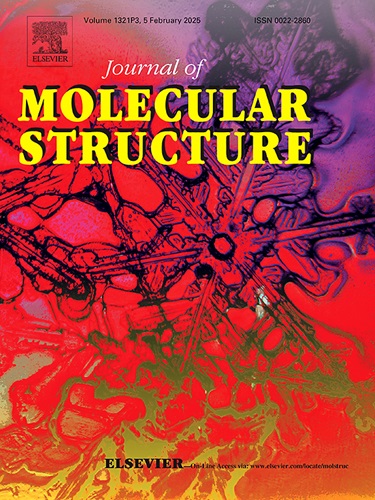Novel anti-breast cancer agents of phenylazopyrazole derivatives: Design, synthesis, Topo IIα inhibitors with potential cytotoxic activity, docking, toxicity and ADME studies
IF 4
2区 化学
Q2 CHEMISTRY, PHYSICAL
引用次数: 0
Abstract
Breast cancer remains a major cause of mortality among women globally. Human DNA topoisomerase II (TopoII) is a nuclear protein that plays a crucial role in modulating DNA configurations during the mitotic phase of the cell cycle. TopoIIα is an important therapeutic target for the development of anticancer drugs due to its significant involvement in tumor proliferation.
In this research article, we synthesized a novel series of pyrazole derivatives featuring the carbimidic N'-(4-nitrophenyl)-2-oxopropanehydrazonic thioanhydride at nitrogen-1, aimed at targeting anti-breast cancer activity (MCF-7) and inhibiting topoisomerase IIα. Our in vitro results demonstrated that six pyrazole derivatives 5f, 5e, 7a, 5d, 3, and 7b effectively inhibited MCF7 cell proliferation, with IC50 values ranging from 3.58 to 8.37 μM. This is notably lower than Doxorubicin's IC50 of 4.260 μM. Additionally, the two most reactive pyrazole derivatives, 5e and 5f, were further tested for their ability to inhibit the topoisomerase IIα enzyme. The results showed that derivative 5e inhibited the enzyme at concentrations of 100 mM, 10 mM, and 1 mM, while derivative 5f inhibited the enzyme at 100 mM and 10 mM only. Both derivatives 5e and 5f also caused significant increases in early, late, and total apoptotic cell percentages, recording values of 64.94 %, 31.35 %, and 96.29 % for 5e, and 46.29 %, 49.91 %, and 96.20 % for 5f, respectively. Furthermore, the results of cell cycle analysis using flow cytometry indicated an accumulation of MCF7 cells in the G2 phase for both derivatives 5e and 5f. The docking studies revealed that these two pyrazole derivatives fit well and were properly oriented within the Topo II-DNA complex. Finally, the pharmacokinetics and toxicity profiles for derivatives 5e and 5f indicated that they are less toxic, suitable for oral bioavailability, and exhibit characteristics that are acceptable for drug-like properties.
新型苯并吡唑衍生物抗乳腺癌药物:设计、合成、具有潜在细胞毒活性的Topo IIα抑制剂、对接、毒性和ADME研究
乳腺癌仍然是全球妇女死亡的一个主要原因。人类DNA拓扑异构酶II (topo异构酶II)是一种核蛋白,在细胞周期有丝分裂阶段调节DNA构型中起着至关重要的作用。TopoIIα因其在肿瘤增殖中的重要作用而成为开发抗癌药物的重要靶点。在本研究中,我们合成了一系列新的吡唑衍生物,该衍生物以碳酰亚胺N'-(4-硝基苯基)-2-氧丙烷腙硫酸酐为氮-1,旨在靶向抗乳腺癌活性(MCF-7)和抑制拓扑异构酶i α。我们的体外实验结果表明,6种吡唑衍生物5f、5e、7a、5d、3和7b能有效抑制MCF7细胞的增殖,IC50值在3.58 ~ 8.37 μM之间。这明显低于阿霉素的IC50 (4.260 μM)。此外,进一步测试了两个活性最强的吡唑衍生物5e和5f对拓扑异构酶i α的抑制能力。结果表明,衍生物5e在100mm、10mm和1mm的浓度下对酶有抑制作用,而衍生物5f仅在100mm和10mm的浓度下对酶有抑制作用。衍生物5e和5f均显著增加了早期、晚期和总凋亡细胞百分比,5e的记录值分别为64.94%、31.35%和96.29%,5f的记录值分别为46.29%、49.91%和96.20%。此外,流式细胞术细胞周期分析结果表明,衍生品5e和5f的MCF7细胞在G2期积累。对接研究表明,这两个吡唑衍生物在Topo II-DNA复合物内匹配良好,取向正确。最后,衍生物5e和5f的药代动力学和毒性谱表明它们毒性较小,适合口服生物利用度,并且表现出可接受的药物样特性。
本文章由计算机程序翻译,如有差异,请以英文原文为准。
求助全文
约1分钟内获得全文
求助全文
来源期刊

Journal of Molecular Structure
化学-物理化学
CiteScore
7.10
自引率
15.80%
发文量
2384
审稿时长
45 days
期刊介绍:
The Journal of Molecular Structure is dedicated to the publication of full-length articles and review papers, providing important new structural information on all types of chemical species including:
• Stable and unstable molecules in all types of environments (vapour, molecular beam, liquid, solution, liquid crystal, solid state, matrix-isolated, surface-absorbed etc.)
• Chemical intermediates
• Molecules in excited states
• Biological molecules
• Polymers.
The methods used may include any combination of spectroscopic and non-spectroscopic techniques, for example:
• Infrared spectroscopy (mid, far, near)
• Raman spectroscopy and non-linear Raman methods (CARS, etc.)
• Electronic absorption spectroscopy
• Optical rotatory dispersion and circular dichroism
• Fluorescence and phosphorescence techniques
• Electron spectroscopies (PES, XPS), EXAFS, etc.
• Microwave spectroscopy
• Electron diffraction
• NMR and ESR spectroscopies
• Mössbauer spectroscopy
• X-ray crystallography
• Charge Density Analyses
• Computational Studies (supplementing experimental methods)
We encourage publications combining theoretical and experimental approaches. The structural insights gained by the studies should be correlated with the properties, activity and/ or reactivity of the molecule under investigation and the relevance of this molecule and its implications should be discussed.
 求助内容:
求助内容: 应助结果提醒方式:
应助结果提醒方式:


